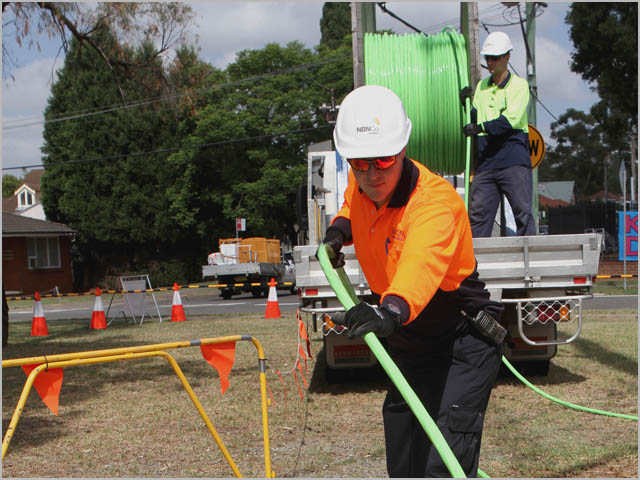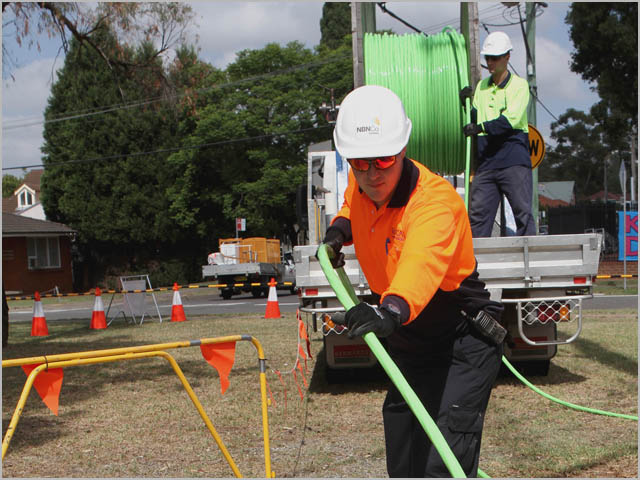
news The National Broadband Network Company today confirmed it would shortly kick off real-world trials in several locations in major Australian cities of the Fibre to the Node and Fibre to the Basement technologies which the Coalition plans to use as key parts of its own Broadband Network project, which is seeing Labor’s all-fibre NBN vision heavily modified.
Under Labor’s NBN policy, some 93 percent of Australian premises were to have received fibre directly to the premise, delivering maximum download speeds of up to 1Gbps and maximum upload speeds of 400Mbps. The remainder of the population was to have been served by a combination of satellite and wireless broadband, delivering speeds of up to 25Mbps.
Originally, the Coalition’s policy was to have seen fibre to the premises deployed to a significantly lesser proportion of the population — 22 percent — with 71 percent covered by fibre to the node technology, where fibre is extended to neighbourhood ‘nodes’ and the remainder of the distance to premises covered by Telstra’s existing copper network. The Coalition’s policy was also to continue to use the HFC cable network operated by Telstra and would also target the remaining 7 percent of premises with satellite and wireless.
However, NBN Co’s Strategic Review published in December last year changed the paradigm, with the company recommending (and the Coalition supporting) a vision in which up to a third of Australian premises will be served by the HFC cable networks of Telstra and Optus, and Fibre to the Node and Fibre to the Basement used in other areas not already covered by Labor’s FTTP approach.
At the company’s first financial results briefing session in Sydney this morning, NBN Co revealed it would shortly kick off real-world trials of the planned FTTN and FTTB technology.
“NBN Co has begun active preparations for the transition to a revised rollout model that is planned to deliver the nationwide upgrade to Australia’s fixed-line broadband infrastructure sooner and at less cost to taxpayers,” the company said in a statement. “It is undertaking a Fibre to the Building (FTTB) pilot and Fibre to the Node (FTTN) trials to assist with the smooth transition to a new architecture subsequent to Commonwealth and regulatory approvals.”
“NBN Co is negotiating a collaborative agreement with Telstra to gain access to its copper access network for the purpose of these tests. This agreement will fall outside the terms of the Definitive Agreements between the two companies.”
The Fibre to the Building pilot will test the rollout of high speed VDSL broadband to end users in ten apartment complexes and office blocks in Carlton, Brunswick and Parkville in Melbourne. Fibre optic cables are being delivered to a telecommunications connection box (or node) located in the communications rooms of the buildings.
The box, in turn, will connect to the existing in-building wiring, enabling Retail Service Providers (RSPs) to deliver broadband to each individual premises. A technology trial in December, in advance of the participation of end users and RSPs, produced download speeds of 108Mbps and upload speeds of 48Mbps, according to NBN Co.
A similar Fibre to the Node build pilot is also being undertaken in two locations: Umina near Woy Woy on the NSW Central Coast and Epping in Melbourne’s northern suburbs. NBN Co will construct two small scale Copper Serving Area Modules, erecting kerbside node cabinets which will connect [NBN fibre] to spare copper pairs in the Telstra pillar. NBN Co stated that neither site had been earmarked to receive FTTP within the next 12 months under the previous rollout plan.
Once active, NBN Co will invite RSPs to participate in a Fibre to the Node end user trial. This limited term trial will test the delivery of high speed broadband via FTTN to up to 100 premises at each location.
NBN Co said that it anticipates it will be in a position to begin the transition to the so-called “Optimised Multi-Technology Mix” as set out in its Strategic Review from calendar year 2015. It added today that it is determined to “stabilise and improve the efficiency of the rollout”, and to help provide ongoing certainty for the Australian construction industry. “As a consequence, the existing Fibre to the Premises (FTTP) rollout in the fixed-line footprint will continue throughout calendar 2014,” the company said.
NBN Co also confirmed that it had commenced negotiations with Telstra on potential changes to the current agreements it has with the company. It has also begun preliminary discussions with Optus around the some of the findings of the Strategic Review.
Separately, NBN Co is also currently conducting a review into the satellite and wireless portions of its rollout. At this morning’s briefing in Sydney, NBN Co executive chairman Ziggy Switkowski acknowledged there were “gaps” in that aspect of NBN Co’s plan.
Chief operations officer Greg Adcock also told the briefing that there were no plans to migrate the users in the FTTN trial to a permanent FTTN service. In addition, he noted that NBN Co was working with Telstra on a separate pilot for deploying FTTN “on a scale basis” that would help NBN Co “effectively scale and expedite the rollout” of FTTN from 2015.
NBN Co chief technology officer Gary McLaren said success in the FTTN trials would be characterised by getting speeds of 50Mbps down and 20Mbps up. These figures more or less represent the Coalition Government’s broadband policy commitment as outlined in April 2013.
Image credit: NBN Co


“NBN Co chief technology officer Gary McLaren said success in the FTTN trials would be characterised by getting speeds of 50Mbps down and 20Mbps up.”
And if the trials produce substantially less than those numbers? What’s their grand plan in that event? Not that they will. Turnbull’s set the bar low enough that NBN Co could fall over it and he’d call it a victory. Plus, I’m betting that despite these being “real world” trials, they’re going to go for the most optimal set up possible – new(ish) and well maintained copper, distances of less than 500m from the node, etc. And even if their trials did fail to get the numbers they want, the government would just spin it as being a victory in principle if not in reality. It’s become clear in recent months that common sense and what’s good for the country and future have nothing to do with the CBN.
Well, if it’s like the other trial, FTTB, you won’t see the full results, you’ll just see Turnbull saying how successful they are while giving the speed obtained by the house adjacent to the node. As to tweaking, I can easily double my sync speed, as long as I can live with the continual dropouts.
Comments are closed.